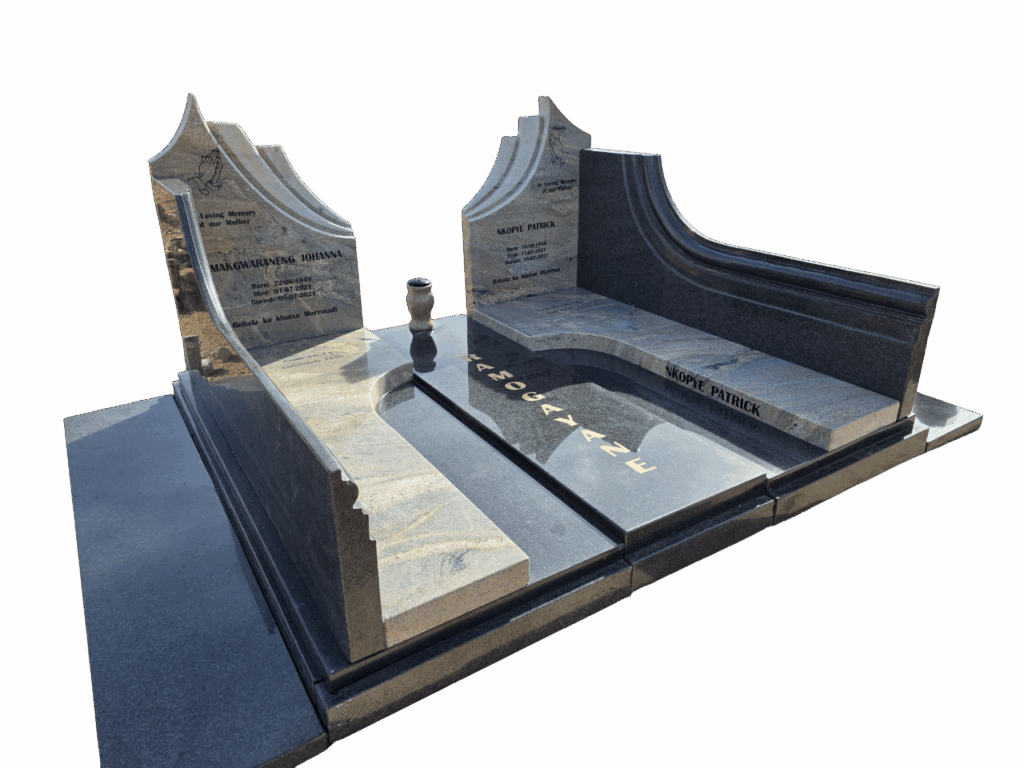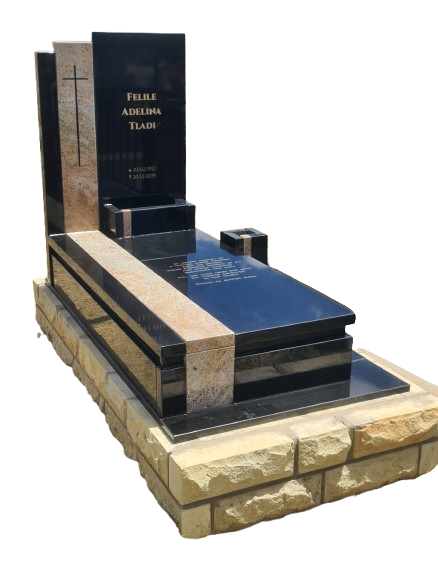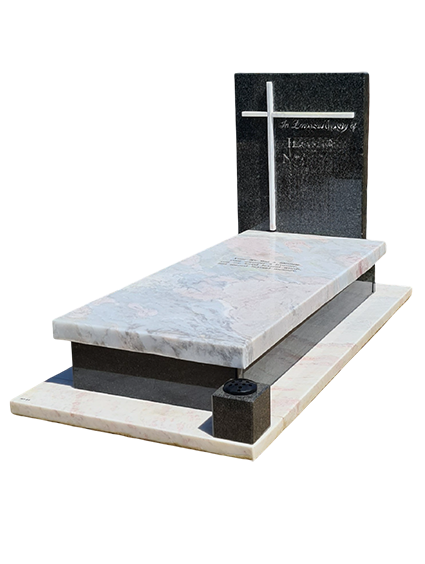Tribute to a
Beautiful Live
At Forever Stone, we know that honoring the memory of your loved one with the right memorial is important. Our compassionate team is here to help you select a tombstone that reflects their unique life and the lasting impact they’ve had on you.
Visit our Northcliff, Johannesburg or Silvertondale, Pretoria branches for more information.
We deliver and install countrywide.
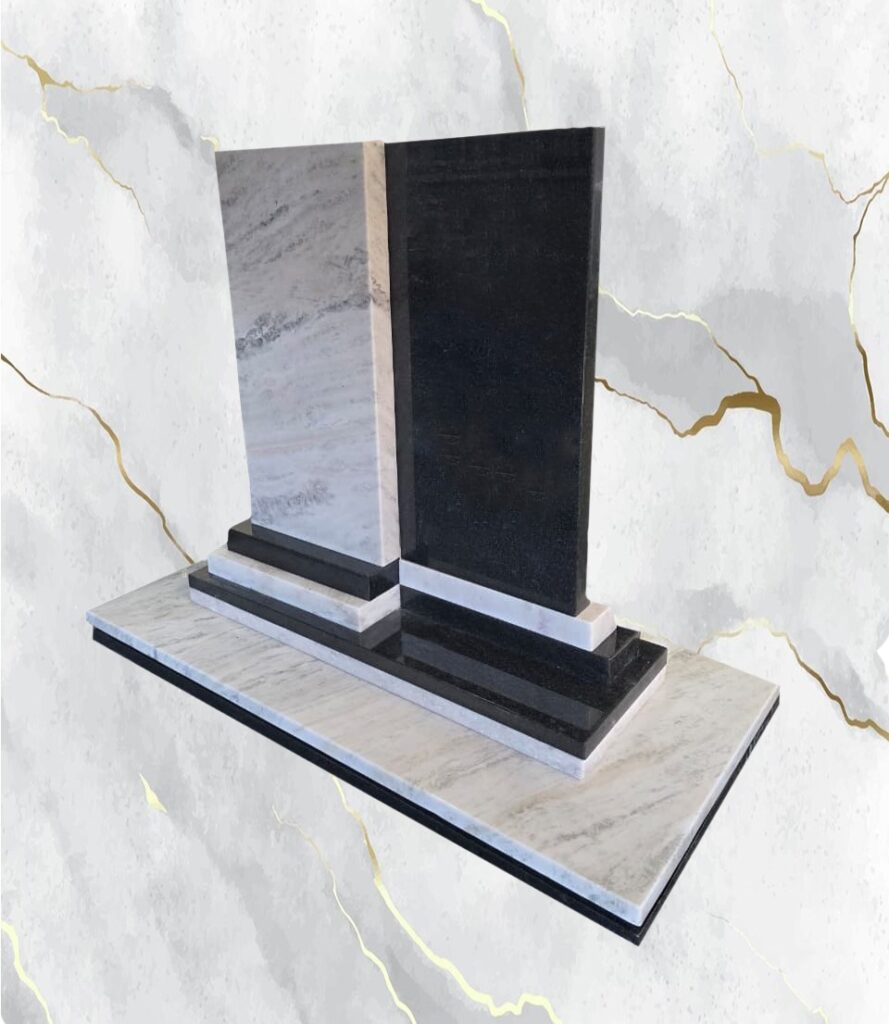
Factory & Showroom Pretoria

The Forever Stone Factory is in high gear to meet order demands as fast as possible.
Please join us to view our selection of samples and discuss how we can create a beautiful tombstone that honors your loved one.
123 Mosaic Rd, Silvertondale, Pretoria, 0184, Unit 7
Showroom Johannesburg
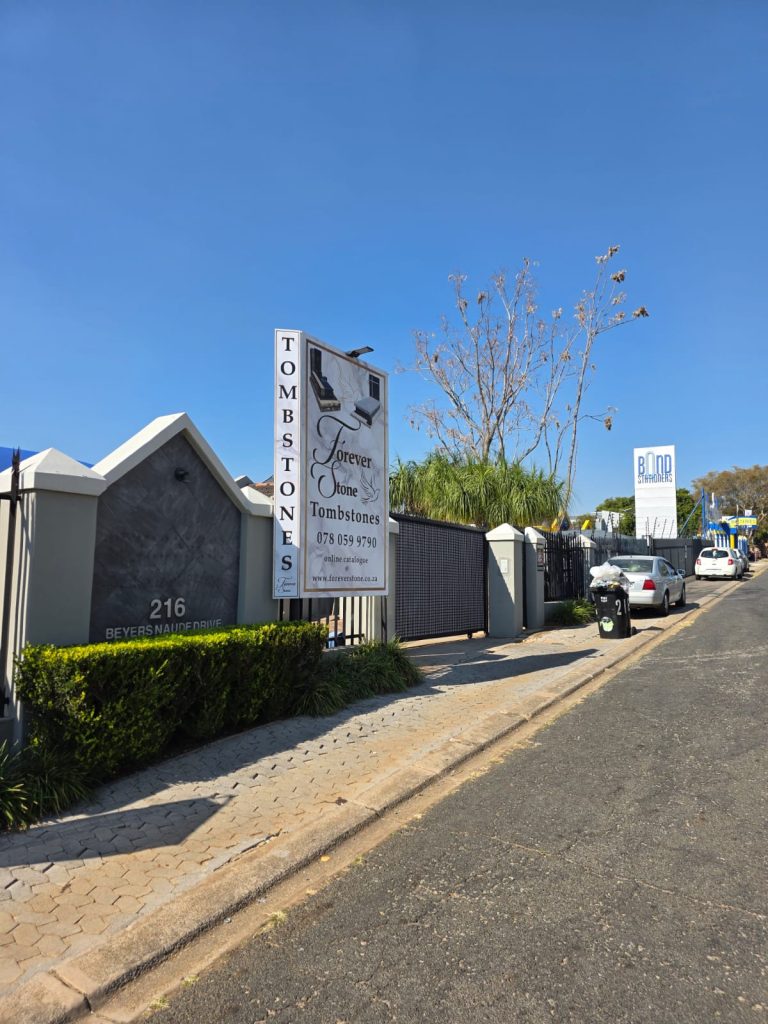
Please join us to view our selection of samples and discuss how we can create a beautiful tombstone that honors your loved one.
216 Beyers Naude Dr, Risidale, Johannesburg
Tombstones Made Of Top Quality Granite
Expertise
As specialists in modern, classic, and personalized tombstone designs, we bring 15 years of expertise in both production and installation. We aim to provide a stress-free and memorable experience for you, offering a range of tombstone options from economical to exquisite designs, available nationwide in South Africa.
Top Quality granite
Customer Satisfaction
Best Service
VARIETY
Tombstone Prices in South Africa: What You Need to Know
When planning a memorial, many families ask: “How much does a tombstone cost in South Africa?” The answer depends on design, material, and customization. While every tombstone is unique, here’s a helpful guide to average tombstone prices:
Basic tombstones (R6,000 – R15,000):
Simple, affordable tombstones made with standard designs and smaller sizes.Mid-range tombstones (R15,000 – R40,000):
Durable and moderately customized options with medium sizes and more variety in materials.Premium tombstones (R40,000+):
High-end tombstones with superior granite, intricate engraving, and fully personalized designs.
💡 Note: Final prices may also depend on cemetery requirements, engraving details, and additional features such as plaques or accessories.
Choosing the right tombstone ensures a meaningful tribute that balances quality, personalization, and budget
Gravestone Inscriptions: What to Include and How to Personalize Them
A gravestone inscription is one of the most meaningful ways to honor a loved one. It typically includes the deceased’s full name, birth and death dates, and a short epitaph or personal message that reflects their life, personality, or relationship with family. Choosing the right wording can create a lasting tribute that truly captures their memory.
1. Basic Information to Include
Every headstone inscription usually begins with essential details:
Full Name: The person’s legal name, sometimes including a nickname if it feels appropriate.
Dates of Birth and Death: These mark the span of their life and offer a timeline for remembrance.
Relationship to Others: Many families choose to include phrases such as “Beloved Mother,” “Cherished Father,” “Devoted Husband,” or “Precious Daughter” to highlight family bonds.
2. Choosing an Epitaph or Personal Message
The epitaph is often the most personal part of the inscription. It can be short and classic, or deeply unique to the individual.
Short and Timeless Examples:
Rest in Peace
Forever in Our Hearts
Gone but Not Forgotten
In Loving Memory
Reflective and Personal Options:
“A life well lived”
“Loved and missed always”
“Their love lives on in our hearts”
“A true friend”
“Forever in our thoughts”
Custom Touches: Families may also include quotes, Bible verses, poetry, or sayings that capture the person’s character, beliefs, or favorite activities.
3. Additional Considerations for Tombstone Inscriptions
When designing the wording for a headstone, you may also want to include:
Religious Symbols or Verses: Crosses, Psalms, or other faith-based inscriptions.
Community or Organization Affiliations: Recognition of their involvement in groups, charities, or cultural communities.
Passions and Hobbies: A symbol or wording that reflects what they loved most in life.
Wishes of the Deceased: If they expressed specific preferences before passing, try to honor them.
Family Wishes: Collaboration with surviving loved ones ensures the inscription is meaningful to all.
4. Where to Find Inspiration and Guidance
Funeral Directors: Many funeral homes offer examples and guidance on headstone wording.
Online Resources: Websites dedicated to epitaphs and memorials can provide inspiration and sample phrases.
Stone Mason or Tombstone Supplier: Professionals can suggest inscriptions that fit both the stone size and family wishes.
Final Thoughts
A gravestone inscription is more than just words—it’s a heartfelt message that represents a loved one’s life and legacy. Whether you prefer a traditional phrase like “Rest in Peace” or a personal message that reflects unique passions and relationships, the right inscription ensures their memory will live on.
Headstone vs Tombstone vs Gravestone: What’s the Difference?
Many people use the terms headstone, tombstone, and gravestone interchangeably today, but historically they each had different meanings. Understanding these differences can help when choosing the right memorial stone for a loved one.
What Is a Headstone?
A headstone traditionally refers to any marker placed at the head of a grave. Today, it’s the most commonly used term and typically describes an upright stone marker engraved with the deceased’s name, dates, and epitaph.
What Is a Tombstone?
The word tombstone originally described the stone slab lid of a stone coffin (or sarcophagus). Over time, the meaning evolved, and now it is widely used to mean the same as headstone—an upright marker placed at a grave.
What Is a Gravestone?
Historically, a gravestone referred to a large stone slab that covered the entire grave, not just the head. While this usage is less common today, the term gravestone is still often used interchangeably with headstone and tombstone.
Modern Usage
Today, the three terms—headstone, tombstone, and gravestone—are used almost synonymously. However, funeral directors, stone masons, and memorial providers typically prefer the term headstone when referring to upright grave markers.
Summary
Headstone: Marker at the head of a grave (modern preferred term).
Tombstone: Originally the lid of a stone coffin, now interchangeable with headstone.
Gravestone: Originally a slab covering the whole grave, now often used like headstone.
Regardless of terminology, each serves the same purpose: to honor and remember a loved one.
Yes, a burial on private property is possible in South Africa, but it requires obtaining a burial order from the local authority and adhering to strict regulations, including a minimum grave depth and a specified distance from water sources, to prevent environmental contamination. You must also ensure the burial is registered and follow health and safety standards to protect the community, so contacting the local municipality and potentially a legal expert is crucial to ensure compliance.
- Burial Order:
No burial may occur without a burial order issued by the local authority under the Births and Deaths Registration Act.
- Health & Safety Standards:
The National Health Act sets the standards for the disposal of human remains, which include requirements for grave depth and registration.
- Distance from Water Sources:
Graves must be a minimum of 50 meters away from any well or other water source to prevent contamination.
- Registration:
The burial must be registered with the relevant local authority.
- Contact Local Authorities:
It is advisable to inform the local police and the municipality before performing a home burial to avoid misunderstandings and ensure they are aware of the situation.
- 1. Obtain a Burial Order:
Get this document from the local authority after registering the death.
- 2. Confirm with the Municipality:
Contact your municipal office to ensure you understand local by-laws and any specific regulations for private burials in your area.
- 3. Check Zoning Laws:
Verify that your property’s zoning permits a private burial and that it meets all requirements, including environmental impact assessments for land use.
- 4. Inform Neighbors and Police:
It’s a good practice to let your neighbors and the local police know in advance about the planned home burial.
- 5. Follow Depth and Placement Rules:Ensure the grave is at least two feet (or the standard grave depth) below the ground and more than 50 meters from any water source.
One of the most common questions families ask is: “When can I put a headstone on a grave?”
Most cemeteries and local councils advise that it takes at least 6 to 12 months for a grave to fully settle. This settling period helps prevent the headstone from tilting, sinking, or becoming unstable over time.
Standard Waiting Periods
6–12 Months: The typical recommended waiting time before placing a headstone.
Beyond 12 Months: In some cemeteries, you may be asked to wait longer than a year, especially if the soil conditions are unstable or the grave has been recently backfilled.
Why Is Waiting Necessary?
Soil Settlement: After burial, the ground naturally shifts and compresses.
Headstone Stability: Installing too early may cause the headstone to lean or crack.
Cemetery Regulations: Each cemetery has its own rules and may enforce minimum waiting times.
Are There Alternatives in the Meantime?
While waiting to install a permanent headstone, families sometimes choose:
Temporary grave markers supplied by the cemetery.
Plaques or wooden crosses to mark the site until the headstone is ready.
Memorial services or tributes at the gravesite to honor the loved one during the waiting period.
Final Thoughts
In most cases, you should plan to wait at least 6–12 months before placing a headstone. Always check with the cemetery or local council, as regulations may vary depending on the location and soil conditions.
Why Do Graves Sink Over Time?
Many families notice that a grave appears to “sink” in the months following a burial. This process is completely natural and unavoidable. A grave will settle as the air pockets escape and the backfilled soil compresses into place. The effect is often more noticeable in wet weather, when soil becomes heavier and compacts faster.
What Causes Grave Sinkage?
The amount and frequency of grave subsidence depends on several factors, including:
Nature of the Backfilled Soil: Loose soil used to fill the grave will naturally settle over time.
Type of Surrounding Ground: Clay, sand, and other soil types compact at different rates.
Weather Conditions: Heavy rain accelerates soil compression, while drier conditions may delay settling.
Grave Depth: Deeper graves may experience more settlement than shallower ones.
Burial Practices: The method of backfilling and whether machinery or hand tools are used can affect settlement.
Is Grave Sinkage a Problem?
In most cases, grave sinking is temporary and cemeteries regularly carry out maintenance to level the ground. Families should not be alarmed, as this process does not affect the coffin or the dignity of the burial.
How Cemeteries Manage Grave Settlement
Cemeteries typically:
Refill or top up the soil where sinking has occurred.
Level the ground to keep the cemetery looking neat and safe.
Advise families to wait 6–12 months before installing a headstone, allowing the soil to settle properly.
Final Thoughts
Grave sinkage is a normal part of the settling process after burial. While it may be unsettling to see, it is not permanent and is easily corrected by cemetery maintenance. Understanding this natural process can provide peace of mind for families.
The Importance of a Strong Tombstone Foundation
A tombstone foundation plays a vital role in ensuring that a memorial remains upright, secure, and stable within the cemetery. Without a proper foundation, a headstone may lean, sink, or even topple over as the ground beneath it shifts and settles over time.
Why Is a Foundation Necessary?
Stability: Provides a solid base to keep the tombstone balanced and upright.
Durability: Prevents damage caused by soil movement, weather conditions, and natural ground settlement.
Safety: Ensures the headstone does not pose a risk of falling or causing accidents.
Longevity: Helps protect the memorial investment by keeping the stone in place for generations.
How Are Tombstone Foundations Made?
Cemeteries and stone masons typically use reinforced materials such as concrete bases to create a level, durable foundation. The exact method may vary depending on:
The type of soil in the cemetery.
The size and weight of the tombstone.
Cemetery regulations on installation requirements.
Foundation and Headstone Installation in South Africa
In South African cemeteries, regulations often require that a foundation be laid before or during headstone installation to ensure safety and compliance. Families are encouraged to consult with their stone mason or funeral director for guidance on local cemetery rules.
Final Thoughts
A solid foundation is essential for every headstone or tombstone. It not only ensures the structural stability of the memorial but also provides families with peace of mind, knowing their loved one’s resting place is secure and well-maintained.
About Us
Forever Stone Tombstone’s factory and showroom is based in Pretoria and a showroom in Cresta, Johannesburg and do installations throughout South Africa. Over time we have started to introduce modern and unique tombstones with high quality in mind. We strive to keep our customers extremely happy as this makes the door open for referrals or returning customers. Please follow the link below to view our tombstone catalogue and prices
Customer Feedback
Refileo Mathabathe
Thank you for helping me honour my later husband. It wat as great pleasure working with your team. You delivered top notch, quality service and I truly appreciate your team for the excellent service you provided.
Boitumelo Selokwane
Thank you for the excellent service you have given me and the great custom made designed tombstone. You did it in style.
Disebo Mohlaloka
Thank you so much for your excellent service. You have realy stepped up and created a tombstone on very short notice. Your service exedid our expectations. Thank you again.
Lay-Bye
Ask about our great lay-bye options for easy payment options.
